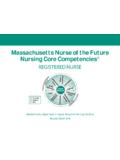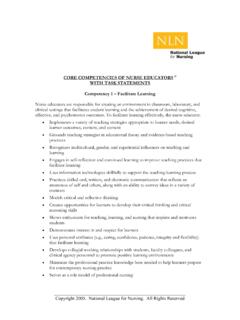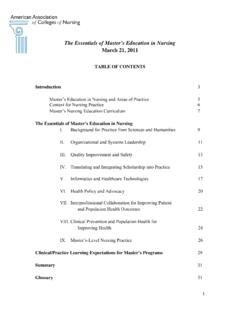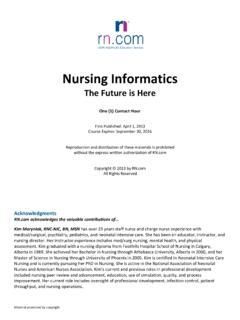Transcription of Precepting Nursing Students
1 Ldkfjas;ldfkjBo Precepting Nursing Students core Knowledge & Skills UNIVERSITY OF WISCONSIN MADISON SCHOOL OF Nursing 2015 Copyright 2015 Board of Regents of the University of Wisconsin System Published by the University of Wisconsin Madison School of Nursing Suggested citation: Precepting Nursing Students : core Knowledge & Skills. School of Nursing , University of Wisconsin Madison (2015). About this Resource This publication is adapted from a program originally developed at the University of Wisconsin Madison School of Nursing as a series of online courses. The program was developed under the direction of Susan J.
2 Zahner from course material contributed by nurses with expertise in Precepting . The course series was originally developed for online use by Brenda J. Kupsch. It was offered in partnership with Continuing Education in Nursing through its online learning portal mynursingce beginning in 2005. During 2007-2009 the course series was supported for use by Wisconsin nurses through the Linking Education and Practice for Excellence in Public Health Nursing (LEAP) Project funded by the Department of Health & Human Services, Health Resources & Services Administration, Division of Nursing (Project #D11HP07731).
3 The course material was revised in 2014 by Sara J. Parrell and redeveloped for online use by Christine A. Lee. It was offered through the mynursingce online learning portal in partnership with the Center for Professional Development and Outreach at the University of Wisconsin Madison School of Nursing until 2015. Christine A. Lee Director for Outreach & Learning Technology Precepting Nursing Students : core Knowledge & Skills Copyright 2015 Board of Regents of the University of Wisconsin System 2 Contents Part 1: Overview Introduction 1) Role of the preceptor 2) Strategies for initiating learning partnerships with Students 3) Key questions to ask before beginning to precept 4) Summary points 5) References Learning Styles & Teaching Strategies 6) Learning Styles 7) Methods for assessing learning style 8) Teaching strategies for effective student learning 9) Summary points 10) References Addressing Challenging Situations 11) Student and preceptor stress 12) Interpersonal conflict 13) Student misconduct 14) Summary points 15) References Precepting Nursing Students .
4 core Knowledge & Skills Copyright 2015 Board of Regents of the University of Wisconsin System 3 Providing Feedback & Evaluation 16) Providing feedback 17) Evaluating student performance 18) Student feedback to preceptors 19) Summary points 20) References Part 2: Overview Teaching Critical Thinking 21) What is critical thinking? 22) Strategies for helping Students learn critical thinking 23) Overcoming student resistance to opportunities to learning critical thinking 24) Indirect strategies for stimulating critical thinking 25) Summary points 26) References Teaching Cultural Competence 27) What is cultural competence?
5 28) Helping Students grow toward cultural and linguistic competency 29) Working with Students from other cultures 30) Working with an interpreter 31) Summary points 32) Resources Precepting Nursing Students : core Knowledge & Skills Copyright 2015 Board of Regents of the University of Wisconsin System 4 33) References Helping Students Learn Interprofessional Practice 34) The Shape of interprofessional practice 35) Supporting student learning for interprofessional practice 36) Strategies to support development of these skills in Students 37) Challenges to supporting interprofessional practice while Precepting 38) Summary points 39) References Helping Students Incorporate Evidence into Practice 40) What is evidence-based practice?
6 41) What are the steps for EBP? 42) Strategies for teaching Students 43) Summary points 44) Resources 45) References Appendix 1: - Kolb Learning Styles and Teaching Strategies Appendix 2: - Example of Student Misconduct Policies and Procedures Appendix 3: - Weekly Journal Appendix 4: - Example of Final Evaluation PART 1: OVERVIEW Precepting Nursing Students : core Knowledge & Skills Copyright 2015 Board of Regents of the University of Wisconsin System PART 1: OVERVIEW PURPOSE To develop the knowledge and skills needed to be an effective practice-based preceptor for Nursing Students with a focus on the role of the preceptor, teaching strategies, addressing challenges, and evaluation.
7 LEARNING OBJECTIVES Define the role of the nurse preceptor and list characteristics of effective preceptors Assess student learning needs and apply relevant teaching strategies Address issues of student anxiety, interpersonal problems, and student misconduct Provide meaningful feedback and evaluate student performance INTRODUCTION Precepting Nursing Students : core Knowledge & Skills Copyright 2015 Board of Regents of the University of Wisconsin System INTRODUCTION One of the most effective mechanisms for teaching undergraduate Nursing Students is the partnering of Students with nurses who are in the role of a clinical preceptor.
8 Since the 1980s it has become a cornerstone of clinical Nursing education. The preceptorship is a formal one-to-one relationship between a student and a nurse that extends over a pre-determined length of time, typically one semester. As a way to bridge theory and practice, and facilitate transition from student to the nurse role in professional practice, the preceptor-student partnership is a vital and esteemed component of the educational system. Nurses new to the role of preceptor share concerns about taking on the challenge and responsibility of supporting and guiding the education of a student.
9 Understanding the role components and addressing key questions related to agency and school of Nursing policies and procedures is critical to role satisfaction and a successful preceptorship. 1) ROLE OF THE PRECEPTOR Schools of Nursing enlist clinical organizations with a commitment to clinical Nursing education to teach student nurses via the role the nurse preceptor, a professional nurse employee of the organization. Being a preceptor can be an extremely rewarding experience (Omansky, 2010): Preceptor achievements and expertise are acknowledged. Participating in student improvement in critical thinking, problem-solving, clinical judgment and skills, setting priorities, and self-confidence provides a sense of accomplishment.
10 Preceptor s commitment to the future of Nursing is validated. INTRODUCTION Precepting Nursing Students : core Knowledge & Skills Copyright 2015 Board of Regents of the University of Wisconsin System Preceptorships provide a pathway for professional development. Affiliation with an academic institution provides contact with faculty, and often access to library resources, ongoing professional advancement classes, and other resources. The success of the preceptorship is determined by the strength of the relationship between the student and professional nurse preceptor.








